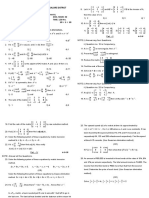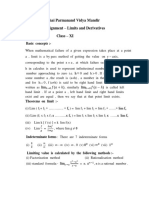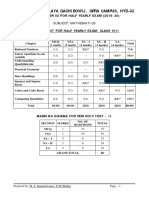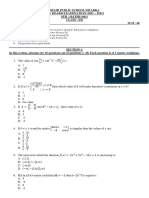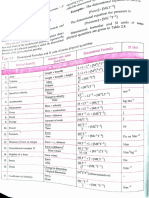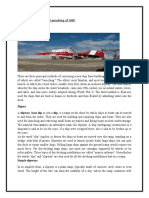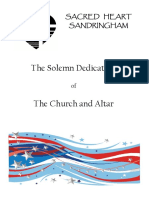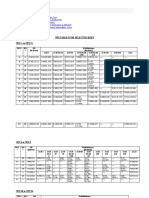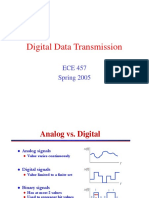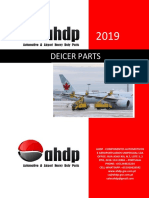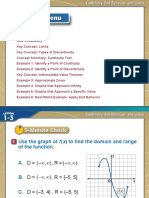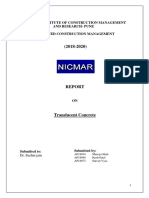S. D.
PUBLIC SCHOOL, PITAMPURA
CLASS - XII
SUBJECT: APPLIED MATHEMATICS (241)
HALF YEARLY EXAMINATION (2024-25)
Time: 3 Hrs M.M - 80
General Instructions:
1. This question paper contains five sections- A, B, C, D and E. Each section is
compulsory. However internal choice is provided in some of the questions.
2. Section A comprises of 18 MCQ based questions and 2 Assertion Reason based
questions of 1 mark each.
3. Section B comprises of 5 Very Short Answer (VSA) questions of 2 marks each.
4. Section C comprises of 6 Short Answer (SA) questions of 3 marks each.
5. Section D comprises of 4 Long Answer (LA) questions of 5 marks each.
6. Section E comprises of 3 source based/case based/passage based/integrated units
of assessment (04 marks each) with sub parts.
7. Internal Choice is provided in 2 questions in Section-B, 2 questions in Section-C, 2
Questions in Section-D. You have to attempt only one alternative in all such
questions.
8. Students are advised to attempt the questions in the order of best known to least
known.
9. If you wish to re-answer any question, then cancel the previous attempt first.
Section – A
(All Questions are compulsory. No internal choice is provided in this section)
1. If 0 < 𝑥 < 1, which of the following is greatest
(a) 𝑥 (b) 𝑥 2
1 1
(c) 𝑥 (d) 𝑥 2
2. If 100 ≡ 𝑥(𝑚𝑜𝑑7), then the least positive value of 𝑥 is
(a) 6 (b) 3
(c) 4 (d) 2
2
3. In what ratio water must be mixed with milk to gain 16 3 % on selling the mixture at cost price?
(a) 1: 6 (b) 6: 1
(c) 3: 2 (d) 2: 3
4. There is a leak at the bottom of a cistern. Due to this it takes 8 hours to fill the cistern. Had
there not been a leak, it would have taken 1 hour less to fill the cistern. How much time does
it take for the leak to completely empty the cistern?
(a) 48 hours (b) 56 hours
1
(c) 55 3 hours (d) 15 hours
5. In a kilometre race, A beats B by 50 metres or 10 seconds. The time taken by A to complete
the race is
(a) 90 seconds (b) 120 seconds
(c) 190 seconds (d) 200 seconds
Page 1 of 7
�6. For a 3 × 3 matrix if adj A = 2A−1 , find |3AAT |
(a) 8 (b) 12
(c) 54 (d) 108
7. The number of all possible matrices of order 3 × 3 with each entry 0 or 1 is
(a) 512 (b) 81
(c) 27 (d) 18
8. Assume 𝑋, 𝑌, 𝑍, 𝑊 and 𝑃 are matrices of order 2 × 𝑛, 3 × 𝑘, 2 × 𝑝, 𝑛 × 3 and 𝑝 × 𝑘 respectively.
The restriction on 𝑛, 𝑘 and 𝑝 so that 𝑃𝑌 + 𝑊𝑌 will be defined are:
(a) 𝑘 = 3, 𝑝 = 𝑛 (b) 𝑘 is arbitrary, 𝑝 = 2
(c) 𝑝 is arbitrary, 𝑘 = 2 (d) 𝑘 = 2, 𝑝 = 3
9. If 𝐴 is an invertible matrix of order 2, then |𝐴−1 | is equal to
(a) |𝐴| (b) 1
1
(c) |𝐴| (d) 0
10. In a 3 × 3 matrix A, value of 𝑎12 𝐴13 + 𝑎22 𝐴23 + 𝑎32 𝐴33 , where 𝐴𝑖𝑗 is the co-factor of the
element 𝑎𝑖𝑗 is
(a) 1 (b) -1
(c) 0 (d) |𝐴|
−𝑥
11. ∫(𝑥 − 1)𝑒 𝑑𝑥
(a) (𝑥 − 2)𝑒 −𝑥 + 𝐶 (b) −𝑥 𝑒−𝑥 + 𝐶
(c) 𝑥 𝑒 −𝑥 + 𝐶 (d) (𝑥 + 1)𝑒 −𝑥 + 𝐶
𝑑2 𝑦
12. If 𝑥 = 𝑡 2 , 𝑦 = 𝑡 3 , then is equal to
𝑑𝑥 2
3 3
(a) (b) 𝑡
2 2
3 3
(c) (d)
2𝑡 4𝑡
13. Derivative of 𝑥 𝑥 w.r.t 𝑥 is
(a) 𝑥 𝑥 (1 − log 𝑥) (b) 𝑥 𝑥 (1 + log 𝑥)
(c) 𝑥 𝑥 (2 + log 𝑥) (d) 𝑥 𝑥 (log 𝑥 − 1)
1
14. If the total cost of producing 𝑥 units of a commodity is given by 𝐶(𝑥) = 3 𝑥 3 + 𝑥 2 − 15𝑥 +
3000, then the marginal cost when 𝑥 = 5 is
(a) ₹ 25 (b) ₹ 35
(c) ₹ 30 (d) ₹ 50
15. The maximum value of the function 𝑍 = 7𝑥 + 5𝑦 subject to the constraints 𝑥 ≤ 3, 𝑦 ≤ 2, 𝑥 ≥
0, 𝑦 ≥ 0, is:
(a) 21 (b) 10
(c) 31 (d) 37
16. The graph of 2𝑥 + 5𝑦 > 10 is the
(a) Half plane containing the origin
(b) Half plane neither containing the origin nor the points on the line 2𝑥 + 5𝑦 = 10
(c) Half plane not containing the origin and not containing the points on the line 2𝑥 + 5𝑦 = 12
(d) Whole XOY-plane excluding the points on the line 2𝑥 + 5𝑦 = 10
17. The corner points of the feasible region determined by a set of constraints are
𝑃(0,5), 𝑄(3,5), 𝑅(5,0) and 𝑆(4,1) and the objective function 𝑍 = 𝑎𝑥 + 2𝑏𝑦 where 𝑎, 𝑏 > 0. The
condition on 𝑎 and 𝑏 such that the maximum 𝑍 occurs at 𝑄 and 𝑆 is
(a) 𝑎 − 5𝑏 = 0 (b) 𝑎 − 3𝑏 = 0
Page 2 of 7
� (c) 𝑎 − 2𝑏 = 0 (d) 𝑎 − 8𝑏 = 0
18. If the time after 640 hours from now will be 9 a.m., then the current time is
(a) 5:00 am (b) 5:00 pm
(c) 4:00 am (d) 4:00 pm
ASSERTION REASON BASED QUESTIONS
In the following questions 19 and 20, a statement of Assertion(A) is followed by a
statement of Reason (R).
Choose the correct answer out of the following choices
(a) Both A and R are true and R is the correct explanation of A.
(b) Both A and R are true and R is not the correct explanation of A.
(c) A is true but R is false.
(d) A is false but R is true.
19. Assertion (A): If the demand function of a product is 𝑝 = 200 − 𝑥 2 , then the revenue on
selling 10 units is ₹ 1000
𝑑
Reason (R): Marginal revenue = 𝑑𝑥 (𝑅), where R is the revenue received by selling 𝑥 units
of a commodity.
1
20. Assertion (A): ∫ 𝑥 log 𝑥 𝑑𝑥 = log 𝑥 + 𝐶
𝑓′(𝑥)
Reason (R): ∫ 𝑓(𝑥) 𝑑𝑥 = log|𝑓(𝑥)| + 𝐶
Section – B
(All Questions are compulsory. In case of internal Choice, attempt any one question only)
𝑑𝑦
21. (a) If 𝑒 𝑦 (𝑥 + 1) = 1, show that = −𝑒 𝑦
𝑑𝑥
OR
(b) A stone is dropped into a quiet lake and wave moves in circles at a speed of 4 cm per
second. At the instant, when the radius of the circular wave is 10 cm, how fast is the enclosed
area increasing?
𝑒 𝑥 (𝑥−3)
22. Evaluate: ∫
(𝑥−1)3
𝑑𝑥
23. Find the point(s) on the curve 𝑦 = 𝑥 3 at which the slope of the tangent is equal to the
𝑦 −coordinate of the point.
24. (a) Determine the integral value(s) of 𝑥 for which the matrix 𝐴 is singular:
𝑥+1 −3 4
𝐴 = [ −5 𝑥+2 2 ]
4 1 𝑥−6
OR
2 −1 10
(b) If 𝑥 [ ] + 𝑦 [ ] = [ ], then find the value of 𝑥
3 1 5
25. Solve the following system of linear inequalities:
2 𝑥 2
− < − + 1 ≤ ,𝑥 ∈ 𝑅
3 3 3
Page 3 of 7
� Section – C
(All Questions are compulsory. In case of internal Choice, attempt any one question only)
4 5 1 −2
26. Find the matrix 𝑋 such that [
]𝑋 = [ ]
1 1 1 3
6 1 −5
27. Express the matrix [−2 −5 4 ] as the sum a symmetric and skew-symmetric matrix.
−3 3 −1
𝑥4
28. Determine the intervals in which the function 𝑓 (𝑥 ) = − 𝑥 3 − 5𝑥 2 + 24𝑥 + 12 is strictly
4
increasing or strictly decreasing.
29. (a) A runs 4 times as fast as B. If A gives B a start of 60 m, how far must be the winning post
on the tracks so that A and B reach there at the same time?
OR
(b) A container has 50 litres of juice in it. 5 litres of juice is taken out and is replaced by 5
litres of water. The process is repeated four more times. What is the amount of juice left in
the container after final replacement?
3𝑥−2
30. (a) Evaluate: ∫
(𝑥+1)2 (𝑥+3)
𝑑𝑥
OR
(𝑥+1)(𝑥+log 𝑥)3
(b) Evaluate: ∫ 𝑑𝑥
3𝑥
31. Solve the following linear programming problem graphically:
Maximize 𝑍 = 4𝑥 + 3𝑦
Subject to
𝑥 + 𝑦 ≤ 800
2𝑥 + 𝑦 ≤ 1000
𝑥 ≤ 400
𝑥, 𝑦 ≥ 0
Section – D
(All Questions are compulsory. In case of internal Choice, attempt any one question only)
50
32. (a) For a monopolist’s product, the demand function is 𝑝 = and the cost function is 𝐶(𝑥) =
√𝑥
0.5𝑥 + 2000. Find the profit maximising level of output. At this level, show that the marginal
revenue and marginal cost are equal.
OR
(b) An event management company charges ₹ 4,800 per guest, for a bulk booking for 100
guests. In addition, it offers a discount of ₹ 200 for each group of 10 guests over and above
100 guest booking. What is the number of guests that will maximise the amount of money the
company receives on a booking? What is the maximum profit on such booking?
33. In a mid-day meal programme, an NGO wants to provide vitamin rich diet to the students of
and MCD school. The dietician of the NGO wishes to mix two types of food in such a way
that vitamin contents of the mixture contain at least 8 units of vitamin A and 10 units of vitamin
Page 4 of 7
� C. Food 1 contains 2 unit per kg of vitamin A and 1 unit per kg of vitamin C. Food 2 contains
1 unit per kg of vitamin A and 2 units per kg of vitamin C. It costs ₹ 50 per kg to purchase
Food 1 and ₹ 70 per kg to purchase Food 2. Formulate the problem as LPP and solve it
graphically to find the minimum cost.
34. (a) In a village in India, a local cooperative society is planning to distribute aid to three
different community projects: a water purification project, a health camp, and a school
development program. The cooperative society has a fixed budget and is aiming to allocate
funds in such a way that each project receives a certain amount of financial support. The total
budget for the three projects is ₹60,000. The amount allocated to the water purification project
is ₹10,000 more than twice the amount allocated to the health camp. The amount allocated
to the school development program is ₹5,000 less than the amount allocated to the water
purification project. Use matrix method to find the amounts allocated to the water purification
project, health camp and school development program.
OR
1 2 −1 −14 −8 5
(b) If 𝐴 = [2 −1 3 ] and 𝐵 = [ 5 5 −5]; find 𝐴𝐵. Use it to solve the following
3 4 2 11 2 −5
system of equations:
𝑥 + 2𝑦 − 𝑧 = 3
2𝑥 − 𝑦 + 3𝑧 = 7
3𝑥 + 4𝑦 + 2𝑧 = 12
35. The current of a stream runs at the rate of 2 km/hr. A motor boat goes 10 km upstream and
back again to the starting point in 55 minutes. Find the speed of the motor boat in still water.
Section – E
(This section comprises of 3 source-based questions (Case Studies) of 4 mark each)
36. CASE STUDY – I
In a residential area in Delhi, a large water tank is managed with three pipes as follows:
• Pipe A can fill the tank in 9 hours.
• Pipe B can fill the tank in 15 hours.
• Pipe C can empty the tank in 30 hours.
Based on the above information, answer the following questions:
(i) If all three pipes are opened together, how long will it take to fill the tank completely?
(1)
(ii) How many hours will it take to fill half the tank by the pipes A and B? (1)
(iii) (a) If Pipe C is closed after 4 hours, how long will it take for the tank to be filled
completely from that point? (2)
OR
(b) It is noticed that Pipe A has a leakage, causing it to fill only 80% of its intended
rate. If Pipe C is closed after 4 hours, how long will it take to fill the tank completely
from that point, considering the leakage in Pipe A? (2)
Page 5 of 7
�37. CASE STUDY – II
A scholarship is a sum of money provided to a student to help him or her pay for education.
Some students are granted scholarships based on their academic achievements, while
others are rewarded based on their financial needs.
Every year a school offers scholarships to girl children and meritorious achievers based on
certain criteria. In the session 2022 – 23, the school offered monthly scholarship of ₹ 3,000
each to some girl students and ₹ 4,000 each to meritorious achievers in academics as well
as sports.
In all, 50 students were given the scholarships and monthly expenditure incurred by the
school on scholarships was ₹ 1,80,000.
Based on the above information, answer the following questions:
(i) Express the given information algebraically using matrices. (1)
(ii) Check whether the system of matrix equations so obtained is consistent or not. (1)
(iii) (a) Find the number of scholarships of each kind given by the school, using Cramer’s
rule. (2)
OR
(b) Had the amount of scholarship given to each girl child and meritorious student
been interchanged, using Cramer’s rule find out what would be the monthly
expenditure incurred by the school? (2)
38. CASE STUDY – III
Analysing the Indian Market for Tea
Page 6 of 7
�In the Indian tea market, the relationship between price and quantity demanded can be
modelled using a linear demand function. Suppose the following information is available
from recent market data:
• At a price of ₹100 per kilogram, the quantity demanded is 2000 tons.
• At a price of ₹150 per kilogram, the quantity demanded decreases to 1500 tons.
Based on the above information, answer the following questions.
(i) Formulate the linear demand function based on the given data. (1)
(ii) Suppose the supply function is given by 𝑆(𝑥) = 500 + 10𝑥, determine the equilibrium
price and quantity. (1)
(iii) (a) Using integration, calculate the consumer surplus at the equilibrium price. (2)
OR
(b) Using integration, calculate the producer surplus at the equilibrium price. (2)
Page 7 of 7













